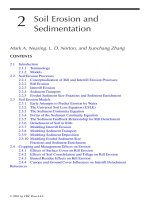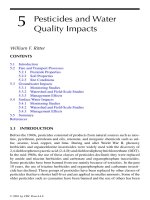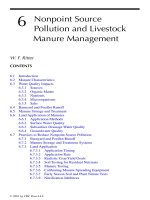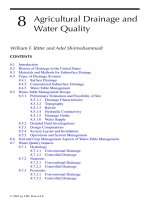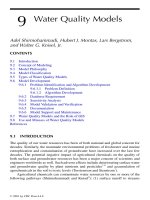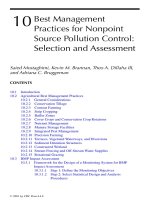Finance management cengage 2013 chapter 020
Bạn đang xem bản rút gọn của tài liệu. Xem và tải ngay bản đầy đủ của tài liệu tại đây (119.66 KB, 30 trang )
Chapter 20
Hybrid Financing: Preferred Stock,
Leasing, Warrants, and Convertibles
Preferred Stock
Leasing
Warrants
Convertibles
20-1
© 2013 Cengage Learning. All Rights Reserved. May not be scanned, copied, or duplicated, or posted to a publicly accessible website, in whole or in part.
Leasing
•
Often referred to as “off-balance-sheet” financing if
a lease is not “capitalized.”
•
Leasing is a substitute for debt financing and, thus,
uses up a firm’s debt capacity.
•
Capital leases are different from operating leases:
– Capital leases do not provide for maintenance
service.
– Capital leases are not cancelable.
– Capital leases are fully amortized.
20-2
© 2013 Cengage Learning. All Rights Reserved. May not be scanned, copied, or duplicated, or posted to a publicly accessible website, in whole or in part.
Lease vs. Borrow-and-Buy
Data:
• New computer costs $1,200,000.
• 3-year MACRS class life; 4-year economic life.
• Tax rate = 40%.
• rd = 10%.
• Maintenance of $25,000/year, payable at beginning
of each year.
• Residual value in Year 4 of $125,000.
• 4-year lease includes maintenance.
• Lease payment is $340,000/year, payable at
beginning of each year.
20-3
© 2013 Cengage Learning. All Rights Reserved. May not be scanned, copied, or duplicated, or posted to a publicly accessible website, in whole or in part.
Depreciation Schedule
Depreciable basis = $1,200,000
Year
1
2
3
4
MACRS
Rate
0.33
0.45
0.15
0.07
1.00
Depreciation End-of-Year
Expense
Book Value
$ 396,000
$804,000
540,000
264,000
180,000
84,000
84,000
0
$1,200,000
20-4
© 2013 Cengage Learning. All Rights Reserved. May not be scanned, copied, or duplicated, or posted to a publicly accessible website, in whole or in part.
In a lease analysis, at what discount rate should cash
flows be discounted?
•
Since cash flows in a lease analysis are evaluated on
an after-tax basis, we should use the after-tax cost
of borrowing.
•
Previously, we were told the cost of debt, rd, was
10%. Therefore, we should discount cash flows at
6%.
rd(1 − T) = 10%(1 – T) = 10%(1 – 0.4) = 6%.
20-5
© 2013 Cengage Learning. All Rights Reserved. May not be scanned, copied, or duplicated, or posted to a publicly accessible website, in whole or in part.
Cost of Owning Analysis
0
Cost of asset
Deprec. tax savings
Maintenance (AT)
1
2
3
-1,200.0
158.4 216.0 72.0
33.6
-15.0 -15.0 -15.0 -15.0
Residual value (AT)
Cash flow
4
-1,215.0 143.4 201.0
57.0
75.0
108.6
PV of the cost of owning (@ 6%) = -$766.948
20-6
© 2013 Cengage Learning. All Rights Reserved. May not be scanned, copied, or duplicated, or posted to a publicly accessible website, in whole or in part.
Notes on Cost of Owning Analysis
•
Depreciation is a tax deductible expense, so it
produces a tax savings of T(Depreciation). Year 1
= 0.4($396) = $158.4.
•
Each maintenance payment of $25 is deductible
so the after-tax cost of the maintenance
payment is (1 – T)($25) = $15.
•
The ending book value is $0 so the full $125
salvage (residual) value is taxed,
(1 – T)($125) = $75.0.
20-7
© 2013 Cengage Learning. All Rights Reserved. May not be scanned, copied, or duplicated, or posted to a publicly accessible website, in whole or in part.
Cost of Leasing Analysis
A-T Lease pmt
•
0
1
2
3
-204
-204
-204
-204
4
Each lease payment of $340 is deductible, so the
after-tax cost of the lease is
(1 – T)($340) = $204.
•
PV cost of leasing (@6%) = -$749.294.
20-8
© 2013 Cengage Learning. All Rights Reserved. May not be scanned, copied, or duplicated, or posted to a publicly accessible website, in whole or in part.
Net Advantage of Leasing
•
NAL = PV cost of owning – PV cost of leasing
•
NAL = $766.948 – $749.294
= $17.654 (Dollars in thousands)
•
Since the cost of owning outweighs the cost of
leasing, the firm should lease.
20-9
© 2013 Cengage Learning. All Rights Reserved. May not be scanned, copied, or duplicated, or posted to a publicly accessible website, in whole or in part.
What if there is a lot of uncertainty about the
computer’s residual value?
•
Residual value could range from $0 to $250,000
and has an expected value of $125,000.
•
To account for the risk introduced by an uncertain
residual value, a higher discount rate should be
used to discount the residual value.
•
Therefore, the cost of owning would be higher and
leasing becomes even more attractive.
20-10
© 2013 Cengage Learning. All Rights Reserved. May not be scanned, copied, or duplicated, or posted to a publicly accessible website, in whole or in part.
What if a cancellation clause were included in the lease?
How would this affect the riskiness of the lease?
•
A cancellation clause lowers the risk of the lease to
the lessee.
•
However, it increases the risk to the lessor.
20-11
© 2013 Cengage Learning. All Rights Reserved. May not be scanned, copied, or duplicated, or posted to a publicly accessible website, in whole or in part.
How does preferred stock differ from common
equity and debt?
•
Preferred dividends are fixed, but they may be
omitted without placing the firm in default.
•
•
Preferred dividends are cumulative up to a limit.
Most preferred stocks prohibit the firm from
paying common dividends when the preferred is in
arrears.
20-12
© 2013 Cengage Learning. All Rights Reserved. May not be scanned, copied, or duplicated, or posted to a publicly accessible website, in whole or in part.
What is adjustable-rate preferred?
•
Dividends are indexed to the rate on treasury
securities instead of being fixed.
•
Excellent S-T corporate investment:
– Only 30% of dividends are taxable to corporations.
– The adjustable rate generally keeps issue trading
near par.
•
However, if the issuer is risky, the adjustable-rate
preferred stock may have too much price instability
for the liquid asset portfolios of many corporate
investors.
20-13
© 2013 Cengage Learning. All Rights Reserved. May not be scanned, copied, or duplicated, or posted to a publicly accessible website, in whole or in part.
How can a knowledge of call options help one
understand warrants and convertibles?
•
•
A warrant is a long-term call option.
•
An understanding of options will help financial
managers make decisions regarding warrant and
convertible issues.
A convertible bond consists of a fixed-rate bond
plus a call option.
20-14
© 2013 Cengage Learning. All Rights Reserved. May not be scanned, copied, or duplicated, or posted to a publicly accessible website, in whole or in part.
A Firm Wants to Issue a Bond with Warrants Package
at a Face Value of $1,000
•
•
Current stock price (P0) = $10.
•
50 warrants attached to each bond with an exercise
price of $12.50.
•
Each warrant’s value will be $1.50.
rd of equivalent 20-year annual payment bonds
without warrants = 12%.
20-15
© 2013 Cengage Learning. All Rights Reserved. May not be scanned, copied, or duplicated, or posted to a publicly accessible website, in whole or in part.
What coupon rate should be set for this bond
plus warrants package?
•
Step 1: Calculate the value of the bonds in the
package
VPackage = VBond + VWarrants = $1,000.
VWarrants = 50($1.50) = $75.
VBond + $75 = $1,000
VBond
= $925.
20-16
© 2013 Cengage Learning. All Rights Reserved. May not be scanned, copied, or duplicated, or posted to a publicly accessible website, in whole or in part.
Calculating Required Annual Coupon Rate for
Bond with Warrants Package
•
Step 2: Find coupon payment and rate.
– Solving for PMT, we have a solution of $110, which
corresponds to an annual coupon rate of
$110/$1,000 = 11%.
INPUTS
OUTPUT
20
12
-925
N
I/YR
PV
1000
PMT
FV
110
20-17
© 2013 Cengage Learning. All Rights Reserved. May not be scanned, copied, or duplicated, or posted to a publicly accessible website, in whole or in part.
What is the expected rate of return to holders of bonds
with warrants, if exercised in 5 years at P5 = $17.50?
•
The company will exchange stock worth $17.50 for
one warrant plus $12.50. The opportunity cost to
the company is $17.50 – $12.50 = $5.00, for each
warrant exercised.
•
Each bond has 50 warrants, so on a par bond basis,
opportunity cost = 50($5.00) = $250.
20-18
© 2013 Cengage Learning. All Rights Reserved. May not be scanned, copied, or duplicated, or posted to a publicly accessible website, in whole or in part.
Finding the Opportunity Cost of Capital for the Bond
with Warrants Package
•
Here is the cash flow time line:
0
1
+1,000
-110
•
...
4
5
6
-110
-110
-250
-360
-110
...
19
-110
20
-110
-1,000
-1,110
Input the cash flows into a financial calculator (or
spreadsheet) and find IRR = 12.93%. This is the
20-19
pre-tax
cost.
© 2013 Cengage Learning. All Rights Reserved. May not be scanned, copied, or duplicated, or posted to a publicly accessible website, in whole or in part.
The Firm is Now Considering a Callable, Convertible
Bond Issue
•
20-year, 10% annual coupon, callable convertible
bond will sell at its $1,000 par value; straight-debt
issue would require a 12% coupon.
•
•
•
Call the bonds when conversion value > $1,200.
P0 = $10; D0 = $0.74; g = 8%.
Conversion ratio = CR = 80 shares.
20-20
© 2013 Cengage Learning. All Rights Reserved. May not be scanned, copied, or duplicated, or posted to a publicly accessible website, in whole or in part.
What conversion price (Pc) is implied by this bond
issue?
•
The conversion price can be found by dividing the
par value of the bond by the conversion ratio,
$1,000/80 = $12.50.
•
The conversion price is usually set 10% to 30%
above the stock price on the issue date.
20-21
© 2013 Cengage Learning. All Rights Reserved. May not be scanned, copied, or duplicated, or posted to a publicly accessible website, in whole or in part.
What is the convertible’s straight-debt value?
•
Recall that the straight-debt coupon rate is 12%
and the bonds have 20 years until maturity.
INPUTS
OUTPUT
20
12
N
I/YR
PV
100
1000
PMT
FV
-850.61
20-22
© 2013 Cengage Learning. All Rights Reserved. May not be scanned, copied, or duplicated, or posted to a publicly accessible website, in whole or in part.
Implied Convertibility Value
•
Because the convertibles will sell for $1,000, the
implied value of the convertibility feature is
$1,000 – $850.61 = $149.39.
$149.39/80 = $1.87 per share.
•
The convertibility value corresponds to the warrant
value in the previous example.
20-23
© 2013 Cengage Learning. All Rights Reserved. May not be scanned, copied, or duplicated, or posted to a publicly accessible website, in whole or in part.
What is the formula for the bond’s expected
conversion value in any year?
•
Conversion value = Ct = CR(P0)(1 + g)t.
•
At t = 0, the conversion value is
C0 = 80($10)(1.08)0 = $800.
•
At t = 10, the conversion value is
C10 = 80($10)(1.08)10 = $1,727.14.
20-24
© 2013 Cengage Learning. All Rights Reserved. May not be scanned, copied, or duplicated, or posted to a publicly accessible website, in whole or in part.
What is meant by the floor value of a convertible?
•
The floor value is the higher of the straight-debt
value and the conversion value.
•
At t = 0, the floor value is $850.61.
Straight-debt value0 = $850.61. C0 = $800.
•
At t = 10, the floor value is $1,727.14.
Straight-debt value10 = $887.00. C10 = $1,727.14.
•
Convertibles usually sell above floor value because
convertibility has an additional value.
20-25
© 2013 Cengage Learning. All Rights Reserved. May not be scanned, copied, or duplicated, or posted to a publicly accessible website, in whole or in part.
